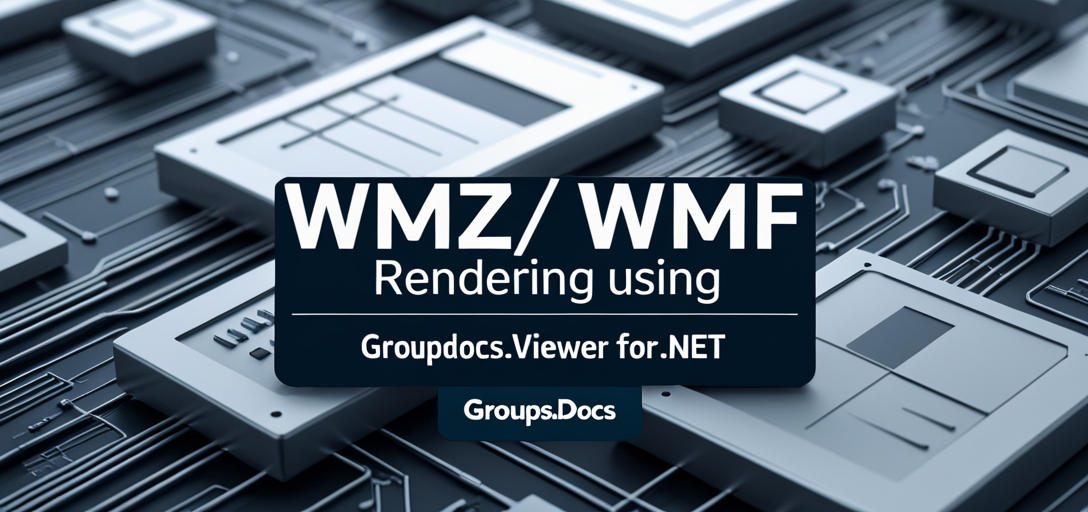Implement .NET WMZ/WMF Rendering with GroupDocs.Viewer for Web and Cross-Platform Compatibility
Introduction
Converting WMZ or WMF documents into accessible formats like HTML, JPG, PNG, or PDF can be challenging. This guide shows you how to render these files using GroupDocs.Viewer for .NET, making them viewable in web browsers and other popular formats.

What You’ll Learn:
- Setting up GroupDocs.Viewer for .NET
- Rendering WMZ/WMF documents into HTML, JPG, PNG, and PDF
- Performance optimization tips for document conversions
Let’s start with the prerequisites required before you begin this implementation journey.
Prerequisites
Before starting with GroupDocs.Viewer for .NET, ensure that you have:
- Basic understanding of C# programming
- Familiarity with .NET framework development
- Visual Studio installed on your machine
You’ll need to install the necessary libraries and dependencies as follows:
Setting Up GroupDocs.Viewer for .NET
NuGet Package Manager Console
Install-Package GroupDocs.Viewer -Version 25.3.0
.NET CLI
dotnet add package GroupDocs.Viewer --version 25.3.0
GroupDocs offers a free trial, which you can use to explore the features without any cost. For extended use, consider acquiring a temporary license or purchasing a full version.
License Acquisition
- Free Trial: Download and install for a limited feature set.
- Temporary License: Obtain from GroupDocs’ website for unrestricted evaluation.
- Purchase: Buy from GroupDocs Purchase to unlock all features permanently.
With the setup complete, let’s initialize GroupDocs.Viewer in your .NET project:
using GroupDocs.Viewer;
// Initialize Viewer object with a sample WMZ document path
using (Viewer viewer = new Viewer("YOUR_DOCUMENT_DIRECTORY/SAMPLE_WMZ"))
{
// Your rendering code will go here
}
Implementation Guide
Now, let’s break down each feature for rendering your documents.
Rendering WMZ/WMF to HTML
Overview: This section covers how to transform a WMZ/WMF document into an HTML file with embedded resources, allowing it to be viewed directly in any web browser.
Step 1: Configure the Viewer Object
using GroupDocs.Viewer;
using System.IO;
string outputDirectory = "YOUR_OUTPUT_DIRECTORY";
string pageFilePathFormat = Path.Combine(outputDirectory, "wmz_result.html");
// Initialize Viewer with your document path
using (Viewer viewer = new Viewer("YOUR_DOCUMENT_DIRECTORY/SAMPLE_WMZ"))
{
// Specify HTML rendering options with embedded resources
HtmlViewOptions options = HtmlViewOptions.ForEmbeddedResources(pageFilePathFormat);
// Render the document as an HTML file
viewer.View(options);
}
- HtmlViewOptions: Defines settings for rendering documents to HTML. Using
ForEmbeddedResourcesensures all assets are included within the HTML.
Troubleshooting Tip: Ensure that your output directory is writable and has sufficient space.
Rendering WMZ/WMF to JPG
Overview: Convert your WMZ/WMF files into high-quality images for easier sharing or embedding in web pages.
Step 1: Setup for Image Conversion
using GroupDocs.Viewer;
using System.IO;
string outputDirectory = "YOUR_OUTPUT_DIRECTORY";
string pageFilePathFormat = Path.Combine(outputDirectory, "wmz_result.jpg");
// Initialize Viewer with your document path
using (Viewer viewer = new Viewer("YOUR_DOCUMENT_DIRECTORY/SAMPLE_WMZ"))
{
// Define options for rendering as a JPG image
JpgViewOptions options = new JpgViewOptions(pageFilePathFormat);
// Render the WMZ/WMF file to JPG format
viewer.View(options);
}
- JpgViewOptions: This class handles conversion settings specific to JPG output, including quality and resolution.
Troubleshooting Tip: Check if your system supports high-resolution image rendering for large documents.
Rendering WMZ/WMF to PNG
Overview: This feature allows you to render vector graphics in WMZ/WMF format into a widely supported PNG image file format.
Step 1: Initialize Conversion Settings
using GroupDocs.Viewer;
using System.IO;
string outputDirectory = "YOUR_OUTPUT_DIRECTORY";
string pageFilePathFormat = Path.Combine(outputDirectory, "wmz_result.png");
// Initialize Viewer with your document path
using (Viewer viewer = new Viewer("YOUR_DOCUMENT_DIRECTORY/SAMPLE_WMZ"))
{
// Set options for rendering as PNG images
PngViewOptions options = new PngViewOptions(pageFilePathFormat);
// Execute the rendering process
viewer.View(options);
}
- PngViewOptions: Configures settings like transparency and color depth.
Troubleshooting Tip: Ensure your output directory path is correctly set to avoid file overwriting issues.
Rendering WMZ/WMF to PDF
Overview: Create a universal document format (PDF) that can be viewed on any device or platform.
Step 1: Prepare for PDF Conversion
using GroupDocs.Viewer;
using System.IO;
string outputDirectory = "YOUR_OUTPUT_DIRECTORY";
string pageFilePathFormat = Path.Combine(outputDirectory, "wmz_result.pdf");
// Initialize Viewer with your document path
using (Viewer viewer = new Viewer("YOUR_DOCUMENT_DIRECTORY/SAMPLE_WMZ"))
{
// Configure options for PDF rendering
PdfViewOptions options = new PdfViewOptions(pageFilePathFormat);
// Render the WMZ/WMF file as a PDF
viewer.View(options);
}
- PdfViewOptions: Sets up specific parameters like page size and margins.
Troubleshooting Tip: Verify that your .NET environment supports required libraries for PDF rendering.
Practical Applications
- Web Publishing: Convert drawings or schematics into HTML for easy web integration.
- Archival Storage: Save document graphics as images (JPG/PNG) to reduce file sizes in archives.
- Documentation: Use PDFs for creating professional reports from vector graphics.
- Cross-platform Sharing: Render WMZ/WMF files into universally accessible formats.
Performance Considerations
- Optimize performance by setting appropriate rendering options like resolution and quality.
- Monitor resource usage to ensure your application remains responsive during conversions.
- Implement caching strategies where applicable to minimize redundant processing.
Conclusion
You’ve now mastered the essentials of using GroupDocs.Viewer for .NET to render WMZ/WMF documents into various formats. This skill can streamline how you handle legacy document types in modern applications, opening up new possibilities for integration and distribution.
As a next step, consider exploring more advanced features of GroupDocs.Viewer or integrating it with other systems to further enhance your application’s capabilities.
FAQ Section
- What is the best format to convert WMZ/WMF for web use?
- HTML is ideal for direct browser viewing without needing additional plugins.
- Can I render large WMZ files efficiently?
- Yes, but ensure sufficient memory and processing power are available.
- How do I handle conversion errors with GroupDocs.Viewer?
- Check log outputs for specific error messages and resolve based on the guidance provided by GroupDocs documentation.
- Is it possible to render only selected pages of a WMZ file?
- Yes, adjust your rendering options to specify page ranges as needed.
- What are some common pitfalls when using GroupDocs.Viewer?
- Common issues include incorrect path configurations and insufficient permissions on output directories.
Resources
- Documentation: GroupDocs Viewer .NET Documentation
- API Reference: GroupDocs API Reference